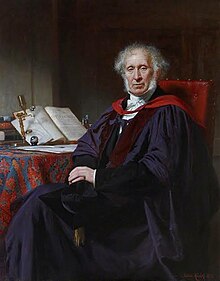Sir David Brewster | |
|---|---|
 Brewster, c. 1824 | |
| Principal of the University of Edinburgh | |
| In office 1859–1868 | |
| Preceded by | John Lee |
| Succeeded by | Sir Alexander Grant |
| 1st Principal of the University of St Andrews | |
| In office 1837–1859 | |
| Succeeded by | Reverend John Tulloch |
| Personal details | |
| Born | 11 December 1781 Canongate, Jedburgh, Roxburghshire, Kingdom of Great Britain |
| Died | 10 February 1868 (aged 86) Allerly House, Gattonside, Roxburghshire, United Kingdom of Great Britain and Ireland |
| Alma mater | University of Edinburgh |
| Known for | Brewster's angle Brewsterite Edge tessellation Kaleidoscope Optical mineralogy Photoelasticity Physical optics Polarized light microscopy Purple fringing Spirit photography Stereoscope |
| Spouses | Juliet Macpherson
(m. 1810; died 1850)Jane Kirk Purnell (m. 1857) |
| Children | 5 |
| Awards | Copley Medal (1815) Keith Prize (1827–29, 1829–31) Royal Medal (1830) Pour le Mérite (1847) |
| Scientific career | |
| Fields | Physics, mathematics, astronomy |
| Notes | |
Founding Director of the Scottish Society of Arts (1821) | |
Sir David Brewster KH PRSE FRS FSA Scot FSSA MICE (11 December 1781 – 10 February 1868) was a Scottish scientist, inventor, author, and academic administrator. In science he is principally remembered for his experimental work in physical optics, mostly concerned with the study of the polarization of light and including the discovery of Brewster's angle. He studied the birefringence of crystals under compression and discovered photoelasticity,[1] thereby creating the field of optical mineralogy.[2] For this work, William Whewell dubbed him the "father of modern experimental optics" and "the Johannes Kepler of optics."[3]
Brewster was a pioneer in photography. He invented an improved stereoscope,[4] which he called "lenticular stereoscope" and which became the first portable 3D-viewing device.[5] He also invented the stereoscopic camera,[6][7] two types of polarimeters,[8] the polyzonal lens, the lighthouse illuminator,[9] and the kaleidoscope.
Brewster was a devout Presbyterian and marched arm-in-arm with his brother during the events of the Disruption of 1843, which led to the formation of the Free Church of Scotland.[10] As a historian of science, Brewster focused on the life and work of his hero, Isaac Newton. Brewster published a detailed biography of Newton in 1831 and later became the first scientific historian to examine many of the papers in Newton's Nachlass. Brewster also wrote numerous works of popular science,[11] and was one of the founders of the British Science Association,[12][13] of which he was elected president in 1849. He became the public face of higher education in Scotland, serving as Principal of the University of St Andrews (1837–1859) and later of the University of Edinburgh (1859–1868). Brewster also edited the 18-volume Edinburgh Encyclopædia.
- ^ Thomas J. Bress (2009), "The Influence of Processing and Fluid Parameters on Injection Molding Flow". University of Michigan. ISBN 1-109-11089-8. p. 14.
- ^ A. D. Morrison-Low (2004) "Brewster, Sir David (1781–1868)" in Oxford Dictionary of National Biography doi:10.1093/ref:odnb/3371
- ^ William Whewell (1859) History of the Inductive Sciences. D. Appleton. p. 133
- ^ John Werge (1890). The Evolution of Photography. Piper and Carter
- ^ International Stereoscopic Union (2006) "Stereoscopy", Numbers 65–72, p. 18. "In 1849 Scottish scientist Sir David Brewster invents the lenticular stereoscope, the first practical, portable, 3D viewing device. This stereoscope used refractive lenses and began the protocol of having the stereo pairs mounted side by side."
- ^ Sir David Brewster. historiccamera.com
- ^ Thomas L. Hankins, Robert J. Silverman (1995) Instruments and the Imagination. Prinston University Press. ISBN 978-0-691-60645-3. p. 157
- ^ Walter G. Egan, Society of Photo-optical Instrumentation Engineers (1992), "Polarization and remote sensing: 22–23 July 1992", p. 225
- ^ "Sir David Brewster – Brewster Kaleidoscope Society". Brewster Kaleidoscope Society.
- ^ Wylie, James Aitken (1881). Disruption worthies : a memorial of 1843, with an historical sketch of the free church of Scotland from 1843 down to the present time. Edinburgh: T. C. Jack. pp. 59–64. Retrieved 18 August 2018.
- ^ In the words of the Round Table Journal (1868): "Sir David Brewster...did more, probably, than has been done by any other one man for the popularization of science." H. E. and C. H. Sweeter, p. 124
- ^ "The BAAS: Origins and Beginnings". Archived from the original on 12 December 2013. Retrieved 16 January 2014.
{{cite web}}: CS1 maint: bot: original URL status unknown (link). baas.research.glam.ac.uk - ^ Science, Optics & You, Pioneers in Optics: "Sir David Brewster", Florida State University